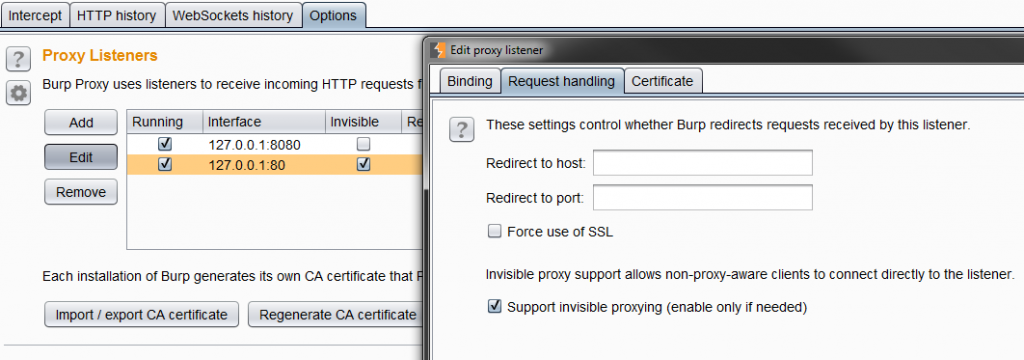Ever came across the issue to redirect HTTP(S) traffic to Burp Suite originating from client software that is not supporting to configure a proxy? Well there are tools like proxychains to do this. But there might be situations were those tools are not suitable. Another way is using the hosts file combined with Burp Suite’s built-in features.
So let‘s assume there is a generic client software not being able to allow the configuration of a proxy server and that does not make use of the system’s proxy configuration. The following guide was tested on Windows 7, but should be adaptable to other operating systems as well.
Manipulate hostname resolution
Usually the client is communicating with one or at least a limited amount of domains. Inspecting the configuration of the client can reveal those domains. Another way would be to run the Linux command strings on all the files of the client an try to find suitable domain names in all the resulting strings.
Having all the domains we should resolve these to the corresponding IP addresses, as we need them later:
ping <domain1>
Please store the domains and the IP addresses.
Now we will change the local hostname resolution to point all the domains to localhost.
/etc/hosts or %windir%\System32\drivers\etc\hosts
127.0.0.1 <domain1> 127.0.0.1 <domain2>
After saving the file, any calls to the above domains will point to 127.0.0.1 instead of the original IP address.
Listen Burp Suite Proxy correctly
Now start Burp Suite if not already done and switch to the Proxy Options. Here one should add a Proxy Listener on port 80 and one on port 443. If your client software is using different ports to connect to server add these instead.
A very important configuration of the Proxy Listener is the invisible option, which turns the proxy in a mode that does not expect CONNECT requests and thus can be hooked in the communication as man in the middle software and not a proxy.
Trying to run the client should result in requests being shown in Burp Suite, but with no responses, as Burp Suite has no clue to where the traffic should be directed to.
Correctly resolve the domains
Let‘s tell Burp Suite where the requests should be sent to. This can be done by using the Burp Suite Option „Hostname Resolution“ in „Project options“ tab. Here we configure the domains and the corresponding original IP addresses, saved from the ping command above.
And that‘s all. The client software is now communicating via Burp Suite to the target system.
- Hooking Burp Suite in Client Software Communication - 6. July 2017
- PHP: Exploitation with $_REQUEST while validating $_GET - 20. May 2016
- HTTP Side-Channel Attacks with Burp Suite - 25. April 2016

